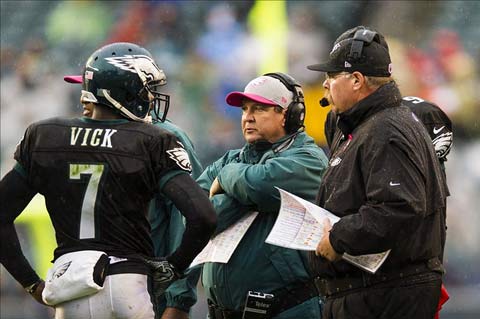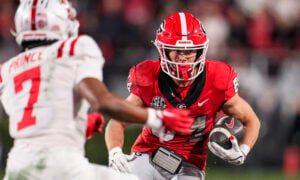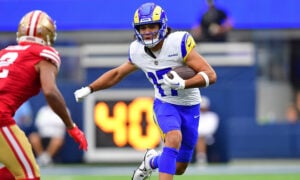The Eagle has (crash) Landed
With the 2012 election still fresh in all our minds, I think it’s fair game to lead with a quotation from former President Bill Clinton, who once said, “you can put wings on a pig, but you don’t make it an eagle.” While I’m not entirely sure of the context, a clearly prescient Clinton could very well have been referring to the recent exploits of Philadelphia’s NFL franchise. Despite being declared both a “Dream Team” by former backup quarterback Vince Young, and more recently a “budding dynasty” by current-ish quarterback Michael Vick, the Eagles have looked more like dodos, as their 2012 playoff chances are virtually extinct.
 Indeed, a loss to the similarly embattled Dallas Cowboys would be the Eagles’ fifth in a row, dropping them to 3-6 on the season. In fact, depending on the enemy Giants’ week ten result, the Eagles could find themselves with a potentially insurmountable four game divisional deficit. With team owner Jeffrey Lurie’s “I’m not saying, I’m just saying” statement regarding coach Andy Reid’s future being hitched to the Eagles’ playoff wagon, it could also mean an end to Reid’s Highlander-esque Philly career.
Indeed, a loss to the similarly embattled Dallas Cowboys would be the Eagles’ fifth in a row, dropping them to 3-6 on the season. In fact, depending on the enemy Giants’ week ten result, the Eagles could find themselves with a potentially insurmountable four game divisional deficit. With team owner Jeffrey Lurie’s “I’m not saying, I’m just saying” statement regarding coach Andy Reid’s future being hitched to the Eagles’ playoff wagon, it could also mean an end to Reid’s Highlander-esque Philly career.
As a dynasty owner, it’s important to be proactive rather than reactive in these types of situations. While nothing is set in stone, it’s sure starting to look like the Eagles franchise is in store for a major upheaval.
Since axing the only head coach hired last millennium is tantamount to mild revolution, it’s reasonable to expect far-reaching changes. Therefore, this hypothetical analysis will attempt to project what will happen to the principle players involved when and if Andy Reid is fired.
Let’s start with the mustachioed man himself.
Andy Reid, HC PHI
Though there will likely be a few head coaching opportunities available (Dallas and Kansas City come to mind), it’s more likely that Reid will accept a lower-level position in order to rehabilitate his image. Some may remember that Reid actually began his career with Green Bay, rising to prominence as the Packers’ quarterbacks coach when some guy named Brett Favre was just starting out. Suffice it to say, Reid is an offensive mind, and as the statistics show below, he prefers to run as pass-first offense.
|
Year |
Total Offensive Plays |
Passing Attempts |
% Passing Plays |
|
2009 |
937 |
553 |
59.02 |
|
2010 |
989 |
561 |
56.72 |
|
2011 |
1004 |
554 |
55.18 |
|
2012 |
540 |
307 |
56.85 |
This selective subset of years encompasses former quarterback Donovan McNabb’s final year with the Eagles (2009) through Michael Vick’s ascendance into the starting lineup. As shown above, the Eagles’ passing peaked in 2009, when McNabb no longer possessed his early career scrambling ability. Even with a mobile Vick, as well as a stud running back in LeSean McCoy, Reid still had his team pass over 55% of the time in 2010 through the present.
Why does this really matter?
If Reid is in fact hired as an offensive coordinator, these past trends dictate that his future team will rely more heavily on the pass. As such, offensive skill player values should be adjusted accordingly.
Michael Vick, QB PHI
The popular line of thinking in Philadelphia is that as Reid goes, so too does Vick. The Eagles have already paid out the majority of his guaranteed money (only $3 million guaranteed for 2013 and beyond), so cutting Vick after the 2012 season would only be a minimal financial burden. Coupling his age (32) and diminishing running ability (shown below) with his polarizing reputation, it’s possible that Vick’s days as a fantasy asset could be numbered.
|
Year |
Games Played |
Rushing Yards |
Rushes |
Rush Yards Per Game |
YPC |
|
2010 |
12 |
676 |
100 |
56.3 |
6.8 |
|
2011 |
13 |
589 |
76 |
45.3 |
7.8 |
|
2012 |
8 |
300 |
54 |
37.5 |
5.6 |
Despite a brief uptick in efficiency in 2011, Vick’s overall rushing numbers have decreased in the past few years, no matter which metric is considered. As these statistics are accompanied by a striking increase in turnovers (32 total since the beginning of the 2011 season) and a leisurely presence in the pocket (134 QB hits so far this year), Vick’s dynasty desirability is currently on the level of a disease.
With that said, there are teams out there who could use him. Jacksonville, Arizona, Kansas City and the New York J-E-T-S, Jets, Jets, Jets are all in need of an upgrade at the quarterback position. However, even if they were tempted by Vick, those aforementioned teams offer little to nothing in terms of game-changing skill position players. If I were a Vick owner, I’d take what I could get for him now.
Nick Foles, QB PHI
Barring an epic trade for the right to draft West Virginia quarterback Geno Smith, the Eagles won’t be in a position to draft a franchise-caliber signal caller in the 2013 NFL draft. Enter Foles. The rookie third-round pick has great measurables (6’5”, 240 pounds), and he compiled excellent preseason stats (63.5%, 3:1 TD/INT ratio, 8.9 YPA). He could be starting for the Eagles as soon as this year, and should be owned in all dynasty leagues.
LeSean McCoy, RB PHI
In the game of football, it would seem reasonable to get the ball into the hands of your best player as often as you can. Unfortunately, despite averaging nearly five yards per carry and over seven yards per reception, LeSean McCoy seems to be the exception to this novel idea. Consider the statistics below:
|
Year |
McCoy Touches |
Total Plays |
% Involvement |
|
2010 |
285 |
989 |
28.8 |
|
2011 |
321 |
1004 |
31.9 |
|
2012 |
176 |
540 |
32.6 |
While trending slightly in the appropriate direction, McCoy still only touches the ball three times out of every ten offensive plays. In doing so, he has yet to exceed 273 rushes in any given year.
So what gives?
While the Eagles have averaged in the top half of the league in rushing attempts under Reid (2010-12), McCoy has only received about 60% of the carries on average. This begs the question, how much of this is due to the running style of Michael Vick? Considering Vick is the ball carrier on roughly 20% of the Eagles’ running plays, evidence would say the answer to that question is “a lot.” If the next Eagles coach prefers a more balanced offense with a prototypical pocket passer, McCoy could truly explode.
DeSean Jackson, WR PHI and Jeremy Maclin, WR PHI
Let’s just jump right to the stats, dating back to Maclin’s rookie season in 2009:
|
Year |
Games |
Catches |
Yards |
Yards Per Catch |
|
2009 (Jackson) |
15 |
62 |
1156 |
18.6 |
|
2009 (Maclin) |
15 |
56 |
773 |
13.8 |
|
2010 (Jackson) |
14 |
47 |
1056 |
22.5 |
|
2010 (Maclin |
16 |
70 |
964 |
13.8 |
|
2011 (Jackson) |
15 |
58 |
961 |
16.6 |
|
2011 (Maclin) |
13 |
63 |
859 |
13.6 |
|
2012 (Jackson) |
8 |
37 |
624 |
16.9 |
|
2012 (Maclin) |
7 |
28 |
356 |
12.7 |
The most striking difference throughout the table above is the disparity in DeSean Jackson’s yards per catch throughout the years. This shows a reliance on the deep ball, which just isn’t always there. Maclin’s yards per catch average has been steadier, and apart from his rookie season and an unhealthy 2012, his reception total has been higher each year as well. This suggests a diversified route tree, which is more conducive to consistent production. Furthermore, as Maclin boasts better size and similar speed to Jackson, his abilities seem more adaptable to a shift in offensive philosophy.
With Vick under center, opposing defenses had to respect both his running ability and strong arm. When the pocket would break down, Vick’s improvisational skills and “schoolyard” abilities were more likely to favor the speedy Jackson. In a more pro-style offense, the guess here is that Maclin will be the bigger beneficiary.
Brent Celek, TE PHI
Celek burst onto the scene in 2009, when he recorded 76 receptions for 971 yards and eight touchdowns. Although this occurred with Donovan McNabb running the offense, it was assumed that Celek’s climb into fantasy stardom would continue with Kevin Kolb running the show. Unfortunately, this has yet to materialize.
A combination of shoddy offensive line play and Michael Vick’s glacial pace releasing the ball (3.12 seconds per drop-back in 2012) have led Celek to block more than his owners would prefer. Since his 2009 breakout, he’s averaged fewer than six targets per game, and secured only 60% of them (68% in 2009). At only 27 years old, it’s possible that a new coaching staff could re-establish Celek as a fantasy-relevant tight end.
Eagles Defense
The Eagles defense is currently best known for employing the “Wide Nine” technique, which spreads the defensive line out in an attempt to increase pressure on the opposing quarterback. While defensive ends Trent Cole and Jason Babin experienced success with this scheme in 2011, the pass rush has been virtually non-existent thus far in 2012. A byproduct of this failure has led to a porous run defense (114 yards per game) and a middling pass defense (229 yards per game). If Reid is fired, it’s more than likely that the next coach will clean house and bring in his own staff. It’s impossible to predict the effect on the Eagles defense, but more likely than not there will be one.
In Conclusion
With the talent they currently possess on both sides of the ball, it’s unfathomable that the Eagles are two games under .500. Whether this is due to coaching mistakes or player errors, the situation is more than likely going to be rectified by management. By utilizing statistical analysis of the key players most likely to be affected, you can stay one step ahead of your competition, and hopefully adjust your lineups accordingly.
Follow me on Twitter @EDH_27


































































